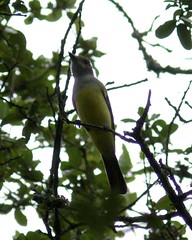
Even though Eastern Phoebes are migratory, they can be found in the neighborhood all year long. I think they might be similar to American Robins in this way. The individual birds we have here in the summer might not be the same ones that are here in the winter. In the summer I usually see Eastern Phoebes only along the creek. They prefer edges of wooded areas next to water, and and I usually see them near the patches of woods we have by the creek rather than out in the open fields that Scissor-tailed Flycatchers and Western Kingbirds prefer. Eastern Phoebes have a distinctive song, and their name comes from part of the song which (sort of) sounds like the word "phoebe". Learning its song is a good way to find these birds, but beware, their song is often copied by our Northern Mockingbirds!

One reason I don't have a good picture of this bird is because it is the most secretive of the 4 flycatchers I'm writing about. It often remains still, perched in denser parts of the tree canopy,. So seeing one can be difficult and it's a real treat when you do. Usually I hear a Great Crested Flycatcher before I see it, and often even after hearing one I can never lay eyes on it. So it's very useful to learn its harsh song and calls here. Like the Eastern Phoebe, the Great Crested Flycatcher prefers forest edges. But unlike the phoebe, it can be found away from the creek as well as near it. So it occurs among the houses in our neighborhood more often than the other flycatchers do, usually in the heavier wooded areas.
Great Crested Flycatchers breed here, and they are only here in the summer; they winter in southern Mexico and Central America. They are the only neighborhood flycatcher that nests in cavities, both old woodpecker holes and artificial structures. So they are the only neighborhood flycatcher that might use a bird house. Here are some guidelines for making one.
I hope my 2 Neighborhood Flycatcher posts encourage you to keep looking for birds in the neighborhood even through our hot summer months. If you can get outside early enough in the morning it can still be quite pleasant, and that's when the birds are most active and easiest to enjoy.
One last note. Moria Darnell is the first person to complete the NASWC Top 20 Bird List and Challenge! On 6/28 she found 2 juvenile Eastern Screech-Owls on Broadmeade Avenue, the last species she needed. Congratulations Moria!

No comments:
Post a Comment